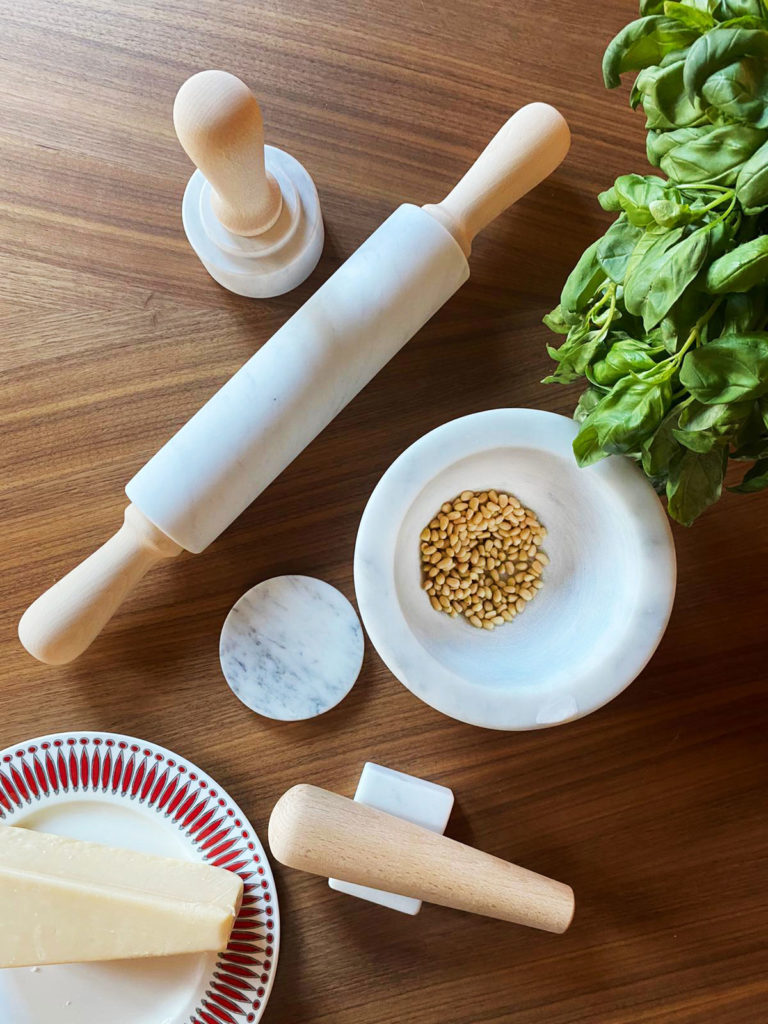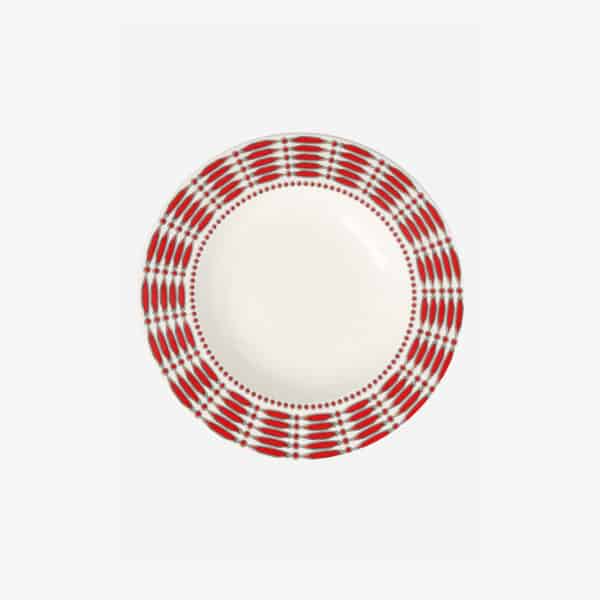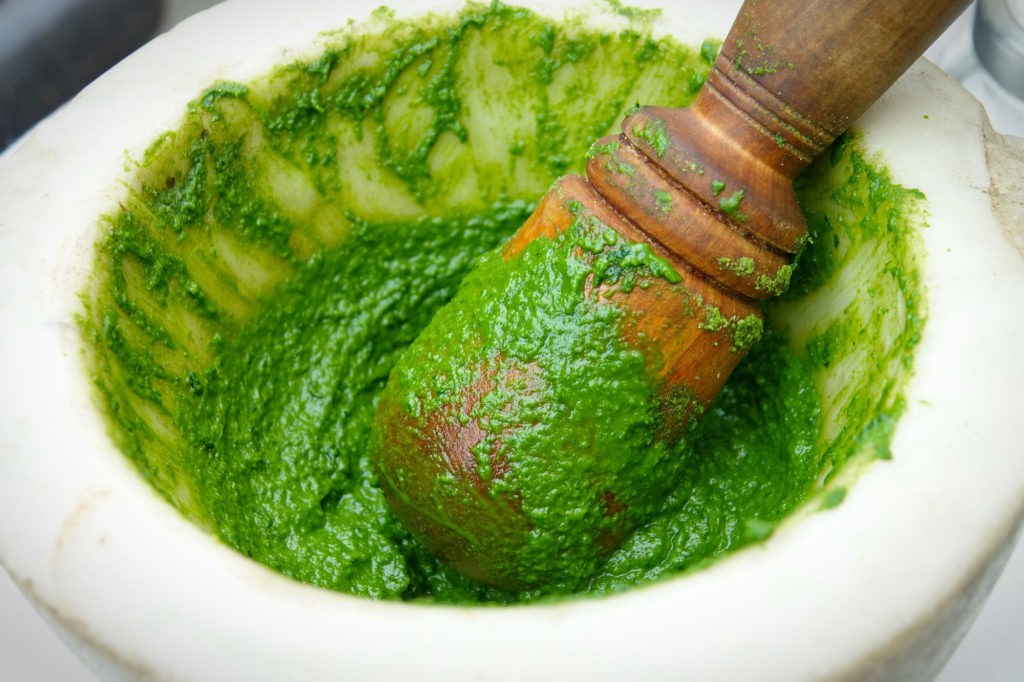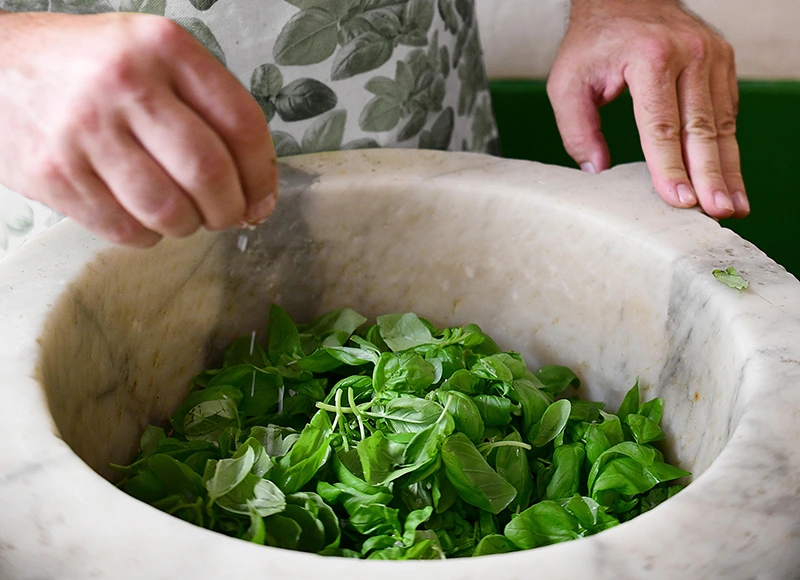Green gift of the Ligurian gods
Mortar and pestle. Check. Pinoli (pine nuts), check. Parmigiano Reggiano DOP and Pecorino Fiore Sardo DOP. Check and check. Basil DOP – only the best basilico di Prà will do. Check. Aglio? (garlic) Boh, it’s up to you. Just make sure all your ingredients are denominazione d’origine protetta (protected designation of origin). Add some high quality EVOO and get ready for a whole lot of pasting. Et voilà, there you have it. Pesto alla Genovese, the green gift of the Ligurian gods.
Culinary origins
To truly understand this much-loved verdant salsa (sauce), we must trace pesto alla genovese back to its origins. As with almost anything in Italy, we find ourselves breaking bread with the Ancient Romans. Back in the day a few millennia ago, Romans enjoyed a special crushed paste of cheese, garlic and herbs known as moretum to spruce up their dishes. It was so popular that there are many written testaments in ancient documents to this special sauce, even Virgil penned a tribute.
Culinary historians believe that pesto alla genovese may have evolved from aggiada (also known as agliata, depending on the Ligurian dialect), a sauce made with garlic, breadcrumbs, olive oil, wine and vinegar and often used with fish. By 1863, Giovanni Battista Ratto put pesto alla genovese and Genovese cuisine on the books in his seminal Cuciniera Genovese. And just a few years later, the Genovese sauce made an appearance in Emanuele Rossi’s 1865 cookbook The True Genoese Cook.

Take a clove of garlic, basil (or marjoram and parsley if you do not have basil), Dutch cheese and Parmesan cheese grated and mixed together all in a mortar with a little butter until it is reduced to a cream. Dilute with light oil in abundance. With this sauce you can dress pasta and gnocchi, adding a bit of hot water without salt to make it more liquid.
~ Giovanni Battista Ratti (Cuciniera Genovese, 1863)
-
 ISSIMO X Villeroy & Boch Peperoncino Deep Plate, Set of 6318,00€ Incl. VAT
ISSIMO X Villeroy & Boch Peperoncino Deep Plate, Set of 6318,00€ Incl. VAT
Elements of flavour
Whatever its history, love for the classic Pesto alla Genovese runs deep. The land of Liguria is generously rich thanks to the region’s close proximity to the Mediterranean Sea, mountainous landscape and fertile earth, all elements which contribute to Liguria’s delightful cuisine which consists of simple dishes and flavours showcasing the best ingredients such as seafood and fish, herbs, olives, nuts, vegetables, mushrooms, beans and pasta.
Pesto is king in the region and almost every family has their own unique recipe. Those from the basil town of Prà are certain that only their lovely green leaves can constitute the real thing. A passionate group of Genovesi more recently founded a Pesto Championship for master pesto makers who believe “Behind pesto is history, and art, and a quality of life.…” Anyone from across the world can enter to win the contest, but according to the organizers “above all, the winner is Pesto, a healthy, natural and democratic sauce.”
Pesto but not genovese
These days, the ubiquitous international status of pesto has left lots of Ligurians lamenting that “pesto” has become an undefined catchall for trendy pastes, a stateless sauce if you will. Once that first pesto ship sailed from Genova many generations ago, the liquid emerald paste was never the same. While pestle and pesto are derivatives of the Italian verb pestare (meaning to smash, crush or pound), Ligurians argue that not all pesto’s are alike. Today, pesto pops up as a sauce for anything and everything and there are even deliciously bright green cousins like pesto di pistacchi, parsley pesto and Arugula pesto, as well as pesto alla moda.

How to enjoy pesto
Often served in traditional pastas such as lasagna or tagliatelle, most visitors to Liguria will find the super traditional trofie al pesto on menus across the region. Trofie originated in the small fishing village of Sori (east of Genova) and was traditionally made using a traditional wooden knitting iron to obtain its lengthy form. This short pasta, made with water, semolina (not flour) and salt , is rolled out by hand and flattened to create its thin and twisted shape. The dish can also be served with green beans and potatoes which have been boiled in the same water.
Pesto is not just for pasta. It is often served to spruce up soup, especially the traditional Ligurian minestrone or as a side condiment for fish or chicken. Others have used it to dress up focaccia. No matter what, however one chooses to indulge, pesto remains one of the hallmarks of Italian cuisine.
A few rules of the land: pesto alla genovese should be made quickly and served fresh to ensure its flavours remain bright and strong. Never heat the sauce, as that impacts the final taste, but rather warm it up by tossing it with fresh cooked pasta.
